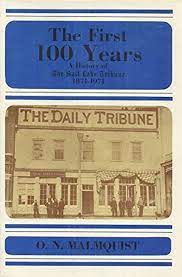Articles/Essays – Volume 07, No. 2
From Gadfly to Watchdog | O. N. Malmquist, The First 100 Years: A History of the Salt Lake Tribune, 1871–1971
For every serious student of Utah’s history, there is a first time to visit the dusty archives or the microfilm files of the Salt Lake Tribune of half a century or more ago.
Two impressions usually emerge. One is of a newspaper filled with vitriolic, anti-Mormon diatribes, each day’s outpouring more bitter than the last, each likely to provide grounds for a dozen libel suits. Another impression is of a lively journal fighting to stay alive in a competitive market by vigorously tackling a variety of controversial issues. By comparison, today’s Salt Lake Tribune — and most other metropolitan dailies—offers bland fare. No one would want to go back to the Tribune’s anti-Mormon period, but it may be fair to ask why today’s “responsible” journalism often succeeds in being dull.
The great virtue of this long-awaited book by the former political editor of the Tribune, O. N. Malmquist, is that it brings back the turbulent years when no one could call the Tribune dull. The reporting was often exciting, the writing vivid, the editorial point of view apparent to the most obtuse reader. The chapters devoted to these years will add to an understanding of Utah’s territorial history and will be welcomed by those who like their history with a bit of journalistic color.
Those who felt this book might be a “house history” whitewashing the Tribune were mistaken. In fact, the publishers of the Tribune, until about 1911, are perhaps too frequently portrayed as opportunistic and petty. The fact that Church leaders did have the means of controlling political decisions within the territory is acknowledged only obliquely. The fact that ballots were not secret and that groups like the Council of Fifty played an important role in Utah political affairs may have had something to do with the Tribune’s frequent outbursts against “ecclesiastical control of politics.”
Malmquist makes no effort to mask the economic motives behind the newspaper’s editorial policies. Founded as the Salt Lake Daily Tribune and Utah Mining Gazette in 1871 by a group of excommunicated Godbeite or “New Movement” members, the newspaper started out as an instrument of moderation but soon moved into direct conflict with the economic and political policies of Brigham Young. The publishers, William S. Godbe and E. L. T. Harrison, soon found that “the irrepressible pressures of the times were in the direction of a gloves-off fight on ecclesiastical as well as economic, political, and social issues. . . .” There were not enough moderate gentiles and Mormons to make a moderate, independently critical newspaper economically viable.
Soon the Church leaders and the Tribune—under a succession of different owners—became locked into opposite positions centering around the “irrepressible conflict”—the struggle over polygamy and Church domination of territorial and local elections. This furnishes a central theme for much of the book. Malmquist skillfully traces the history of Mormon-Gentile hostility, the years of accommodation following the 1890 Manifesto, the drive for statehood, and the early years of statehood.
The chapters on Thomas Kearns, the colorful mining entrepreneur and owner (after 1901) of the Tribune, will give many readers a more flattering portrait of this man than they may have had before; his lack of formal education and misuse of the English language have generated a body of folklore depicting him as a one-dimensional, rich, ignorant millionaire. Although Malmquist does not add a great deal of previously unknown information about Kearns’ political career, he does improve Kearns’ image.
The story of the key figure in the newspaper’s later history, J. F. Fitzpatrick, is told as perhaps only Malmquist could tell it. This man, whose passion for anonymity was his trademark, was a key figure in the “power structure” of Salt Lake City and Utah for many years. His role as close friend and confidant of Church presidents Heber J. Grant, George Albert Smith, and David O. McKay is recounted. (Heber J. Grant once told Malmquist, “One of my best friends, inside or outside the Church, is your publisher, John Fitzpatrick.”) It is clear that Fitzpatrick set the newspaper firmly on the only sensible course it could pursue in the long run, turning it away from issues that divided Mormons and non Mormons and strengthening it for the years when many newspapers across the nation had to combine or die.
The chapters on the latter decades of the Tribune’s life are filled with the struggle for survival. They are valuable for their history of the rivalry between the Deseret News and the Tribune, as well as for accounts of the rise and fall of several now long-departed Salt Lake dailies. These chapters may be a bit con troversial for those who regret the establishment of a joint publishing agency and who see the Tribune publishers’ involvements in other business enterprises as a mixed blessing for the community.
For the past sixty years, Malmquist observes, the Tribune has sought “to accept the responsibilities of public watchdog but to avoid the role of public gadfly.” One can approve the transformation of the Tribune into a watchdog while at the same time regretting, in some ways, the passing of the gadfly.
The First 100 Years: A History of the Salt Lake Tribune, 1871-1971. By O. N. Malmquist. Salt Lake City: Utah State Historical Society, 1971. 454 pp. $8.00.


 Back to full Issue
Back to full Issue

